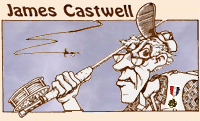|
Let me try to paint a picture for you; several in fact. These are most likely things
we have all done a time or two.
You ready your fly gear, attaching a tiny dry attractor pattern and ease your way
carefully into the shallow stream. You study the water flowing toward you looking
for any sign of a rise, seeing none you start the systematic patterning of the area,
working stealthily against the flow until you raise a nice trout and with practice land
and release it easily back to the stream. Only to get busted by the fish cops! You
broke two laws. You must stay on the bank and you may not fish blind, only
to actively rising fish.
Or this scenario. You have your fishing license, have taken all of the basic instruction
classes and after a few years have graduated from the spinning level to the top group
of fishers, the fly-fishers. You are allowed to keep two fish today. The first is smaller
than some bait you have used on other days and you slide it nonchalantly back so as
not to be seen. Really? Busted again. Catch and kill is the law here. Catch and
release is illegal.
After hours you've produced the flies you need, have landed in the country of destination,
arranged and paid for the section (beat) of river where you will be allowed to fish, tied
on your nymph and eased your way downstream using the practiced down-and-across
casting pattern. Busted! No wading in the stream and no downstream fishing wet
(nymphing.)
No, none of this is happening in the United States of America. Yet.
Or this. Repeatedly swinging your bright egg-colored pattern past the nose of the steelhead,
she takes a swipe at it, if for no other reason than to get it out of the redd. She is not as big
as the male you took from the tail of the redd just downstream an hour ago. But, she is
bright, a real 'chromer!' A real trophy. Neither are as big as the salmon you landed after
a short fight yesterday. A huge dark male working his way back downstream after spawning.
Sometimes called 'black' salmon, sometimes drop-backs. Bad for you here; fishing to
spawning fish, fishing in a redd, and fishing for fish that have spawned. They will throw away
the key on you this time.
But, this is the good old U.S.A. All of the above is legal here, for now. Each item mentioned
in all of the above is illegal in some countries. Yes, every one of them. These are
only a few of the examples of how other countries view and manage their resources.

Perhaps we take some things for granted, especially as we are new to any sport. We think
it's all ours; to do with as we feel like, when we feel like. We paid for a license, probably.
We can confuse 'privileges' with 'rights,' and at times it seems far too easy to do. What
about the slaughter of the Bison, Passenger Pigeon, Whooping Crane, the Pacific salmon?
We are enjoying what's left now. The good, the bad, and yes, some of the ugly. There
is far more to fly-fishing than learning to catch fish with flies, far more. Stewardship of our
environment is it's own reward; fly-fishing is only a window opening onto it. But, be
cautioned, it is a one-way trail; there may be forks, but there is no turning back. Once
learned, it can not be forgotten. And you have started.
Remember, you may have first heard of fly-fishing in school. A past conservationist
President Teddy Roosevelt is still quoted as, "Walk softly and carry a big stick."
He must have referred to fly-fishing. ~ J Castwell
|





